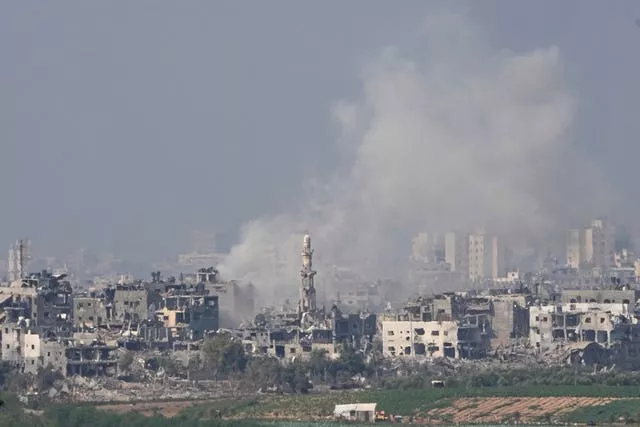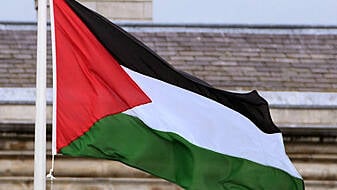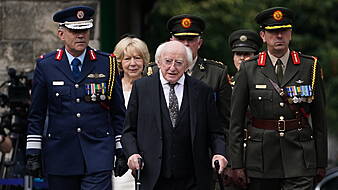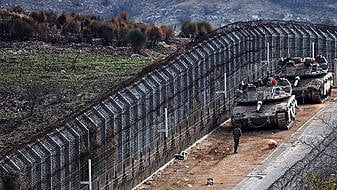Israel has expanded its ground operation in Gaza, sending in tanks and infantry backed by massive strikes from the air and sea.
Prime Minister Benjamin Netanyahu called it a war for Israel’s existence, and said: “Never again is now.”
The country’s defence minister said “the ground shook in Gaza” and that the war against the territory’s Hamas rulers has entered a new stage.
The bombardment, described by Gaza residents as the most intense of the war, also knocked out most communications.
This largely cut off the besieged enclave’s 2.3 million people from the world while enabling the Israeli military to control the narrative in a new stage of fighting.
The military released grainy images on Saturday showing tank columns moving slowly in open areas of Gaza, many apparently near the border, and said warplanes bombed dozens of Hamas tunnels and underground bunkers.
The underground sites are a key target in Israel’s campaign to crush the territory’s ruling group after its bloody incursion in Israel three weeks ago.
“We moved to the next stage in the war,” defence minister Yoav Gallant said in remarks broadcast on Saturday.
“Last evening, the ground shook in Gaza. We attacked above ground and underground. … The instructions to the forces are clear. The campaign will continue until further notice.”
His comments signalled the gradual ramping-up toward what is expected to evolve into an all-out ground offensive in northern Gaza.
Early in the war, Israel had already amassed hundreds of thousands of troops along the border. Until now, troops had conducted brief nightly ground incursions before returning to Israel.
The Palestinian death toll in Gaza on Saturday rose to just over 7,700 people since October 7, with 377 deaths reported since late Friday, according to the territory’s health ministry.

A majority of those killed have been women and minors, the ministry said.
Ministry spokesman Ashraf al-Qidra told reporters the disruption of communications has “totally paralysed” the health network.
Residents had no way of calling ambulances and emergency teams were chasing the sounds of artillery barrages and airstrikes to search for people in need.
Some civilians were using their bare hands to pull injured people from the rubble and loading them into personal cars or donkey carts to rush them to the hospital.
Other residents travelled by foot or car to check on their relatives and friends.
Israel says its strikes target Hamas fighters and infrastructure, and that the militants operate from among civilians, putting them in danger.
Across Gaza, terrified civilians were huddling in homes and shelters with food and water supplies running out. Electricity was knocked out by Israel in the early stages of the war.
More than 1.4 million people have fled their homes, nearly half crowding into UN schools and shelters.

Aid workers say the trickle of aid Israel has allowed to enter from Egypt in the past week is a tiny fraction of what is needed.
Gaza hospitals have been scrounging for fuel to run emergency generators that power incubators and other life-saving equipment.
The intensified air and ground campaign also raised new concerns about dozens of hostages dragged into Gaza on October 7.
On Saturday, hundreds of relatives of hostages gathered in a square in downtown Tel Aviv, demanding to meet with Prime Minister Benjamin Netanyahu and defence minister Mr Gallant.
Some in the group demanded that Israel push for the release of all hostages before proceeding with the campaign against Hamas.

Mr Gallant later said he would meet with the families on Sunday.
In Cairo, Egyptian President Abdel Fattah el-Sissi said his government was working to de-escalate the conflict through its talks with the warring parties to release prisoners and hostages.
Meanwhile, the spokesman of the Hamas military wing offered a comprehensive swap of hostages for the thousands of Palestinian prisoners held by Israel.
The spokesman, using the nom de guerre Abu Obeida, said in a televised speech that the price for freeing the hostages, said by Israel to number 229, is “emptying the Zionist prisons of all detainees”.
Military officials have said they are trying to both topple Hamas and bring back the hostages but have not explained how they could obtain both objectives at the same time. The families of the hostages fear Israel’s ramped up offensive in Gaza is endangering the captives.
The Israeli army spokesman, Rear Admiral Daniel Hagari, said four hostages were released in recent days through mediation by Qatar and Egypt.
Rear Adm Hagari dismissed news reports about a possible ceasefire deal in exchange for the release of hostages, saying Hamas was engaged in a “cynical exploitation” of relatives’ anxieties.
Later on Saturday UN secretary-general Antonio Guterres reiterated his appeal for an immediate humanitarian ceasefire in Gaza, the unconditional release of hostages and a delivery of humanitarian aid the strip’s 2.3 million people.
“This situation must be reversed,” he said in a statement following his meeting in Doha with Qatar’s Prime Minister Sheikh Mohammed bin Abdulrahman bin Jassim Al-Thani.
“This is the moment of truth. Everyone must assume their responsibilities. History will judge us all.”
He warned that the ongoing escalation, including relentless Israeli bombardment and a communication blackout, would have devastating impacts and undermine “the referred humanitarian objectives”.







